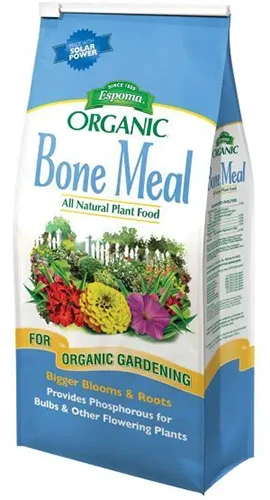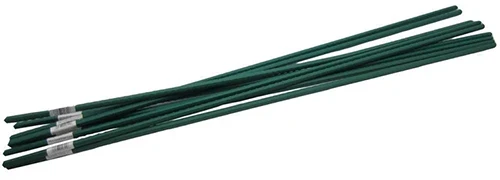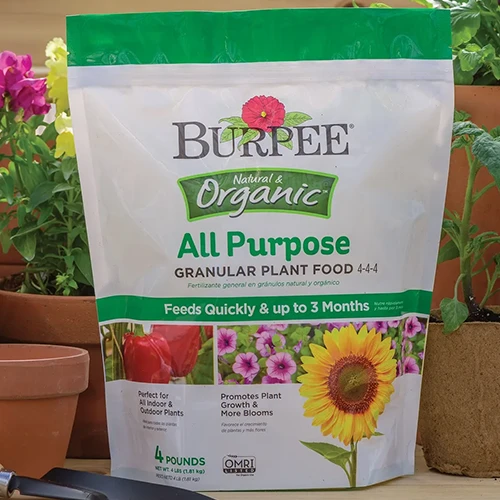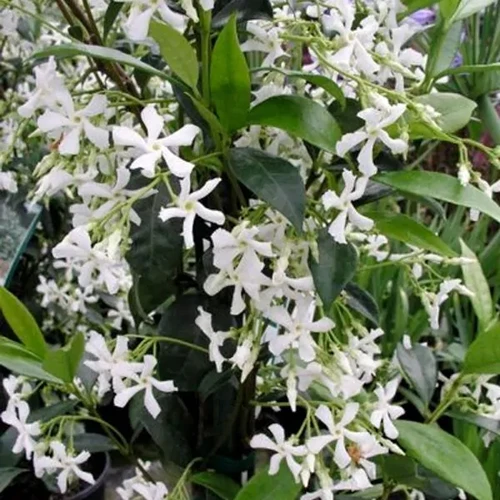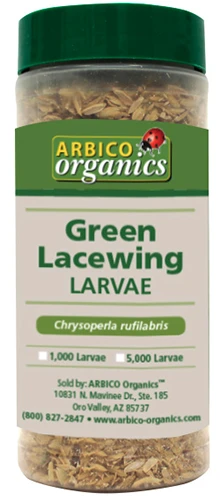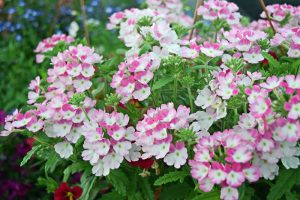Trachelospermum jasminoides
A beautiful vine popular for its vigorous climbing habit and highly fragrant flowers, star jasmine, Trachelospermum jasminoides, also makes an effective and attractive ground cover.

We link to vendors to help you find relevant products. If you buy from one of our links, we may earn a commission.
These gorgeous climbers have long, flexible vines used for ascending vertically up trees or trellises.
And they’re easily trained to spread horizontally, forming a thick, dense mat of glossy green foliage loaded with pretty star-shaped flowers in late spring.
Once established, the vines spread quickly and can add several feet of growth in a single season. And after their first year, these low-maintenance plants develop good drought tolerance as well.
As a bonus, the handsome foliage is evergreen and keeps its good looks year-round.
New spring growth emerges tipped in bronze and purple, and flowering is most heavy in late spring with lighter blooms over summer. A touch of cold weather gives the foliage beautiful autumnal colors of burnished burgundy, carmine, gold, scarlet, and purple.
Easily cultivated, the sturdy vines make a fabulous choice for low barriers, borders, foundations, and as a filler in scrubby areas or scrambling over retaining walls, rocks, and stumps.
Easy-care and attractive all year, it’s ideal for thick, lush mats of flowers, foliage, and fragrance!
Does that sound like something your garden needs? Then let’s dig in to learn how to grow star jasmine as a ground cover.
Here’s what’s coming up:
What You’ll Learn
What Is Star Jasmine?
As a climbing vine, star jasmine, also known as Chinese or southern jasmine, can reach 10 to 20 feet high.
When planted as a ground cover, the tendrils typically reach two to five feet tall and can spread up to 10 feet.

During their first summer, growth might seem slow but the roots are busy getting established, and it’s helpful to keep the soil lightly moist for young plants.
After plants are well-established, topside growth catches up with the roots and plants grow quickly. Watering can be reduced at this time as established vines have good drought tolerance.
T. jasminoides is a warm-climate perennial and reliably hardy in USDA Zones 8 to 10.
In colder regions, the vines can be enjoyed as a container plant to be sheltered over winter, but regular freezing temperatures prevent success as a ground cover.
Star Jasmine Propagation
The best time for planting is in spring or fall when daytime temperatures are warm and evenings cool.
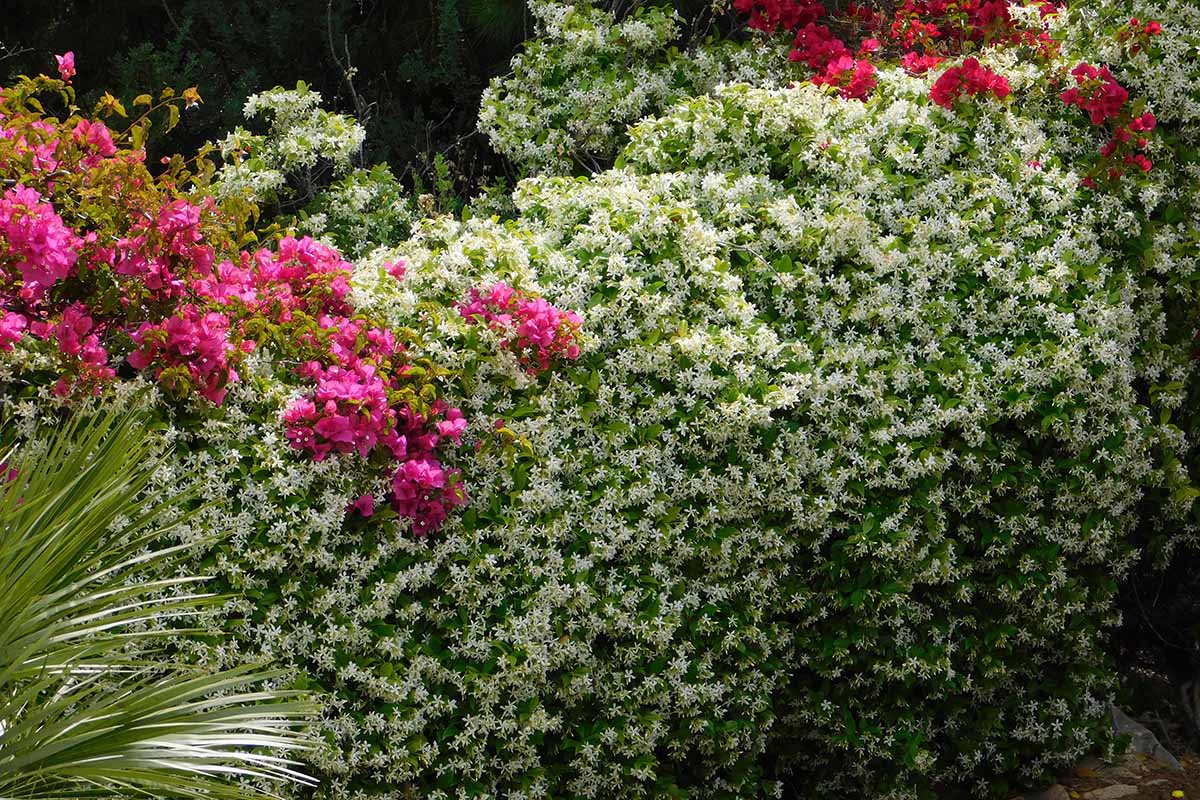
Vines can be planted in summer as well, but they’ll require more water as they strive to become established.
To plant, use a garden fork or spade to loosen the soil to the same depth and twice as wide as the nursery pot the vines came in.
Mix in a few handfuls of compost or well-rotted manure to enrich the soil. These plants are light to moderate feeders but perform best when started in fertile soil.
Mix in some grit for good drainage. Use materials such as landscape sand, pea gravel, perlite, or rock chips to keep water moving freely and to prevent soil compaction.
Add in one to two tablespoons of bone meal for strong, healthy roots.
You can find four- and 24-pound bags of Organic Espoma Bone Meal at Nature Hills Nursery.
Set plants in place at the same level as in the nursery container, with the crown about one inch below the soil line.
Space plants three to five feet apart. This distance gives the roots room to spread for a strong foundation and the vines will quickly fill in the gaps to form thick, luxurious mats of foliage.
Backfill with soil and firm lightly in place.
Water gently but deeply. For the first year of growth, keep the soil lightly moist but not wet.
Read more about propagation techniques here.
How to Grow Star Jasmine Plants
Star jasmine is adaptable to many soil types, but for consistent growth with ample flowers, use a fertile, loamy soil with good drainage and a slightly acidic pH of 5.5 to 6.5.
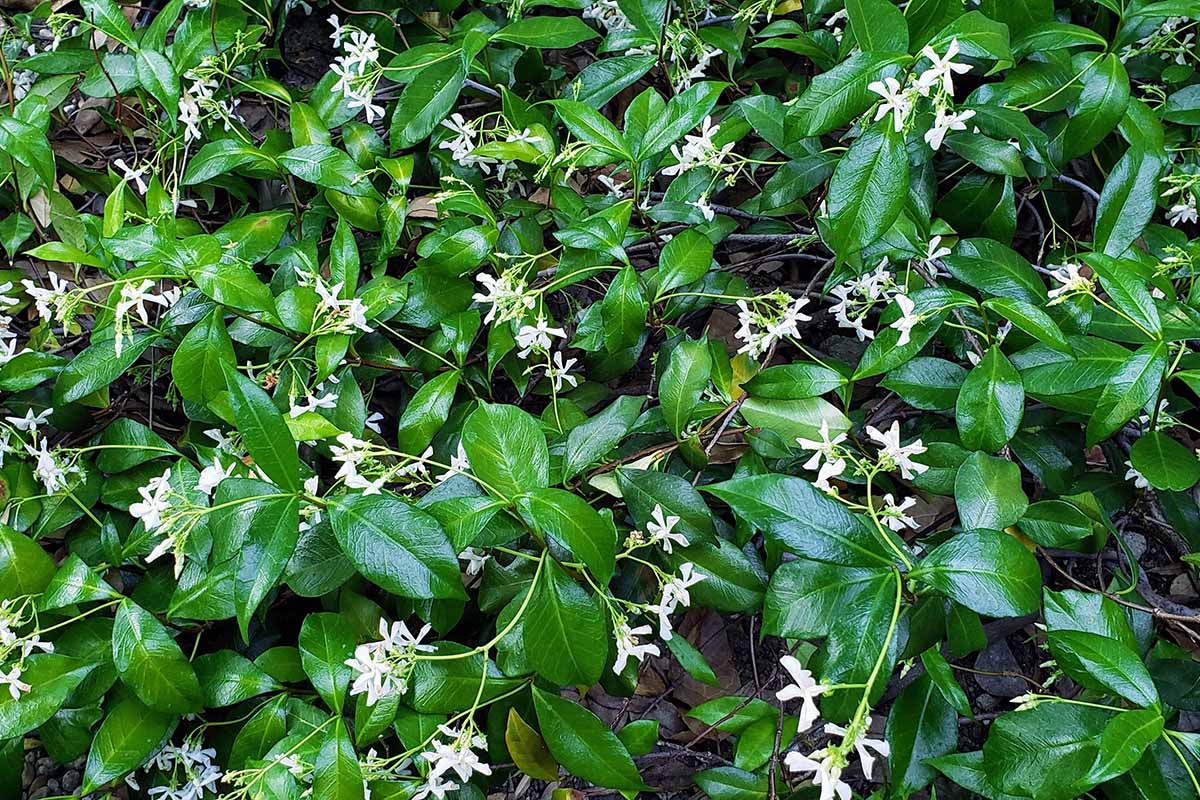
The plant tendrils will spread freely and naturally on their own.
But if you want to guide them in a certain direction, attach the vines to 12- to 36-inch stakes using garden velcro, plant clips, or twine. Insert the stakes into the soil where you want the vines to grow.
The stakes can be removed next year, but leave them in place for a full growing season to train the vines to stay put.
Arlmont & Co. has garden stakes with a steel core and poly coating for lightweight but strong support available at Wayfair.
Once the space between plants starts to fill in, new tendrils use the existing vines to scramble over, filling in gaps nicely and adding volume.
Feeding and Fertilizers
Light feeders, star jasmine is best fertilized with a balanced, all-purpose fertilizer such as 10-10-10 NPK.
Scatter an application of slow release pellets once in early spring and again in early summer, right after the main wave of flowers have finished.
Burpee Natural Organic All Purpose Granular Plant Food
Burpee Natural Organic All Purpose Granular Plant Food has balanced a 4-4-4 NPK ratio and is available at Burpee.
Alternatively, use a liquid or water-soluble mix and reapply once more after flowering.
Watering Needs
Provide young plants with one to two inches of water per week until they become established, keeping the soil lightly moist but not wet.
After plants are established, reduce watering and allow the top one to two inches of soil to dry between water applications.
Also, young plants can benefit from the addition of mulch to help retain soil moisture and keep weeds in check.
Add a two- to four-inch layer of mulch over the root zone, using materials such as bark mulch, grass clippings, hay, or straw. Remove it the following spring, or once plants are established.
Growing Tips
- Grow in fertile, well-draining soil.
- Fertilize in early spring and again in midsummer.
- Water established plants when the top one to two inches of soil dries out.
Pruning and Maintenance
These vines are wonderfully low maintenance and care is minimal.
After it’s established, star jasmine is a vigorous grower and can become a touch unruly or wild in habit. Annual pruning quickly restores order and a tidy appearance.
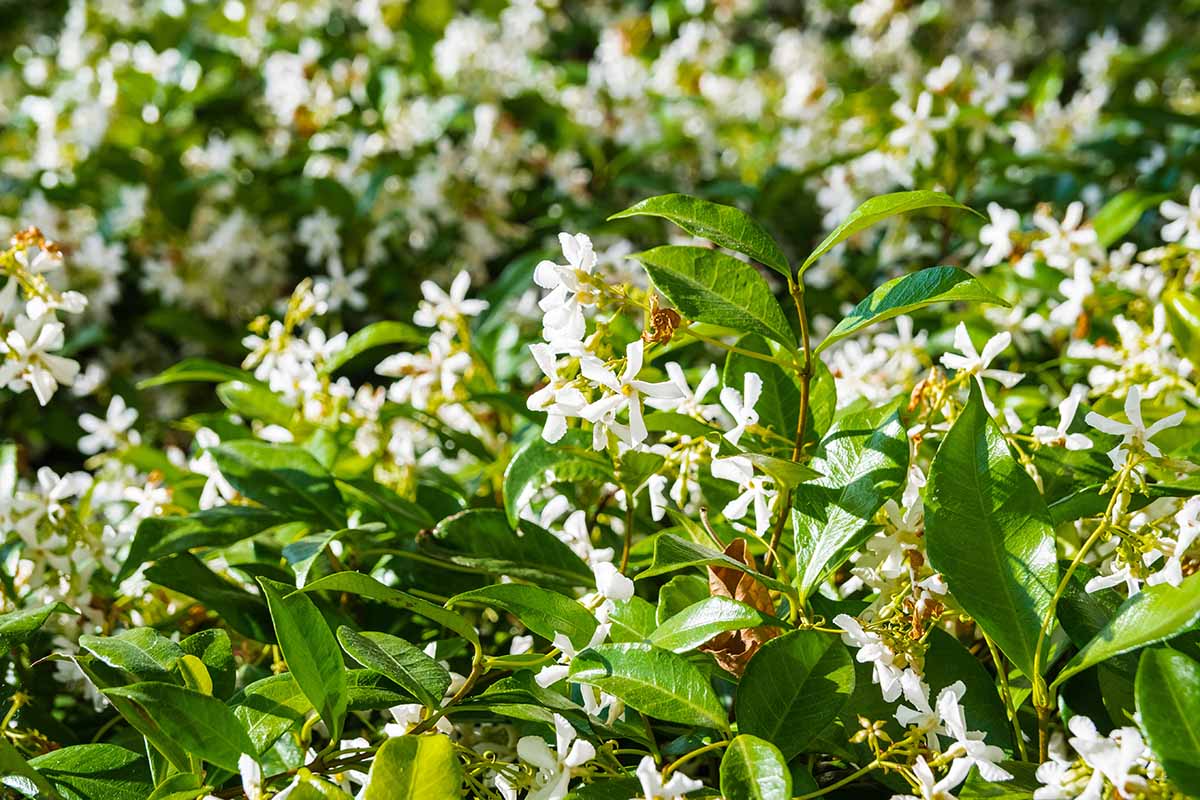
The best time to prune is right after flowering in early summer. Pruning at this time encourages branching and new growth, producing ground covers that are dense and lush.
Use clean, sharp pruning shears or an electric trimmer to reduce the height of tendrils to two or three feet.
If trails are escaping over borders or spreading into areas where you don’t want them, trim them back at the same time to create clean edges.
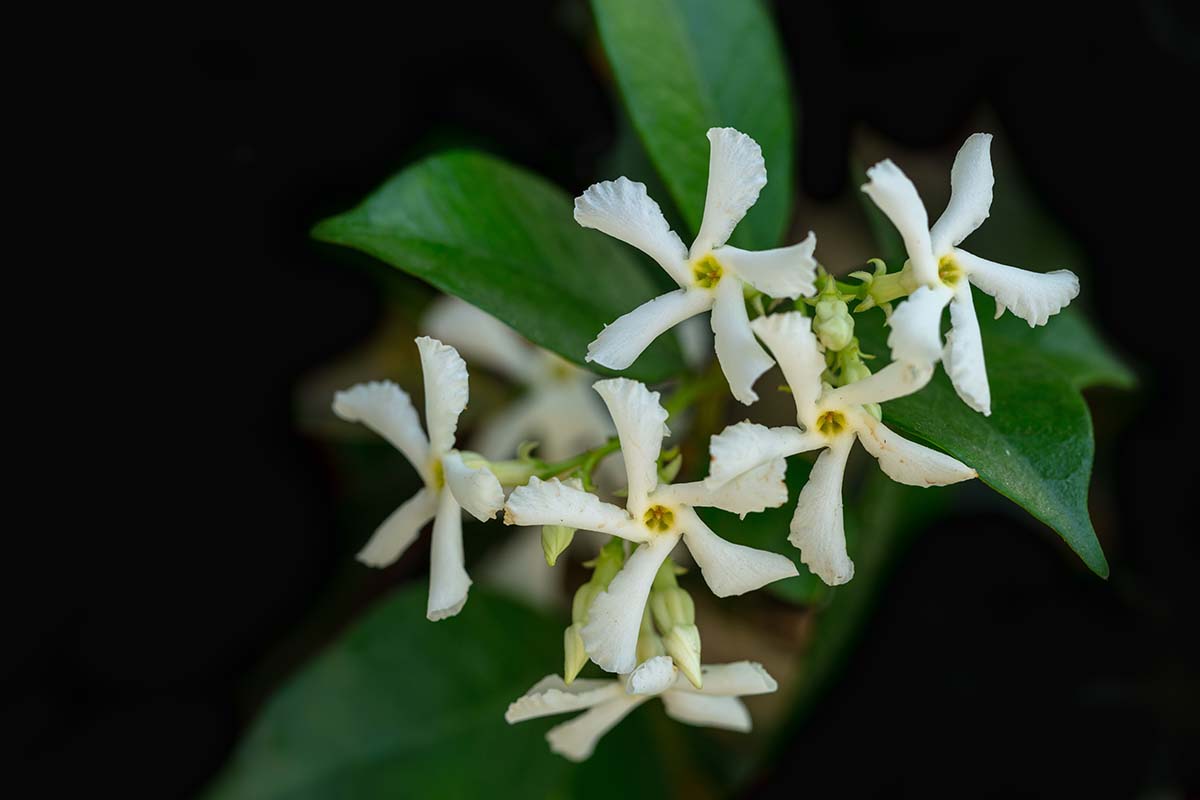
Plants can also be lightly trimmed after the growing season is finished – but use a gentle touch just to tidy up overgrown or straggling vines and don’t cut plants back hard at this time.
Flowers form from old wood and a hard pruning in fall means less flowers the following spring.
Be sure to wear gloves, long sleeves, and eye protection when pruning. When cut, the stems of T. jasminoides emit a sticky white sap that can cause skin irritation in some people.
In late winter, groom plants lightly. Remove any broken, dead, or straggling stems and clean up dead leaves and debris.
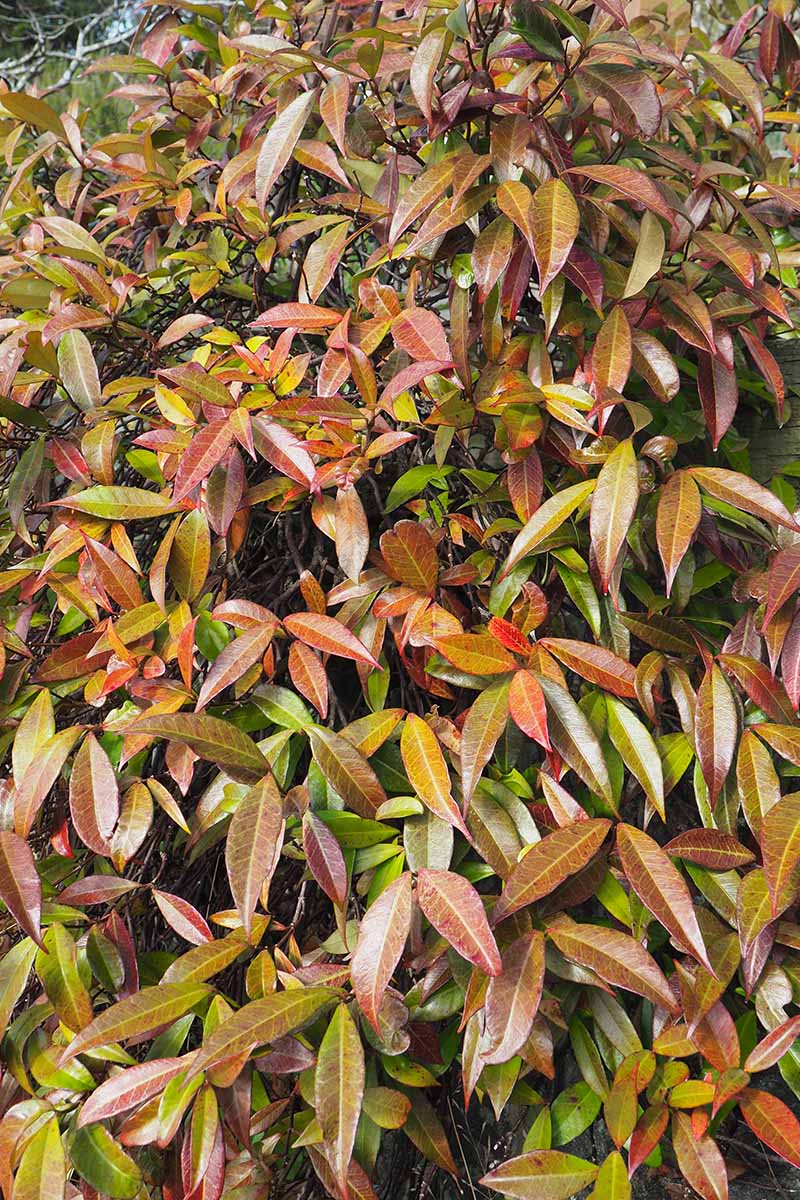
Star jasmine can temporarily endure temperatures down to 10°F, but not extended freezing temperatures.
Should a cold snap threaten, provide protection with floating row covers, straw, or pine boughs.
Star Jasmine Cultivars to Select
T. jasminoides species plants feature beautiful, pinwheel-shaped flowers of pure white with glossy, deep green foliage.
Breeding is somewhat limited, but there are a few cultivars that offer lovely variations.
‘Madison’ has a slightly better cold tolerance and is hardy in Zones 7 to 10.
‘Chameleon’ is a variegated cultivar with creamy, pale yellow streaks to the foliage, and ‘Fragrant Gold’ has all-gold leaves.
‘Rose’ features pretty pink flowers. And there are yellow-flowered cultivars as well, such as ‘Star of Toscane.’
Species plants in quart-size nursery pots are available at Nature Hills Nursery and Plants By Mail.
Planting Tree offers transplants in gallon-size containers.
Managing Pests and Disease
In general, star jasmine is a healthy, vigorous vine but there are a few issues to be aware of.

The most common pests are mealybugs and scale.
Mealybugs are small, gray insects that look a bit like a white, cotton-like growth on leaves and stems. A large infestation can eventually cause leaf drop.
A strong jet of water from the garden hose is often enough to dislodge them or they can be sprayed with an insecticide for persistent infestations.
Black scale are small, round sapsuckers that excrete honeydew onto plants, which can lead to discolored and distorted leaves, and black sooty mold.
Introducing predatory insects like green lacewing, ladybugs, or parasitic wasps is a natural way to clear out scale problems.
The larvae of green lacewings can be found at Arbico Organics.
For severe infestations, cut out infected stems and leaves and discard or burn the plant material.
Rabbits also like to chew on tender new growth, but tend to leave the older, leathery foliage and woody stems alone.
Our guide on how to keep rabbits out of the garden offers tried and true bunny solutions.
Star jasmine isn’t prone to issues with disease, but keep an eye out for root and crown rot, caused by water molds in the Phytophthora genus.
Symptoms include wilting and leaf drop. To avoid root and crown rot, take care not to overwater and be sure to plant in well-draining soil.
Quick Reference Growing Guide
| Plant Type: | Perennial vine | Flower/Foliage Color: | White/dark green |
| Native to: | China | Maintenance: | Low |
| Hardiness (USDA Zones): | 8-10 | Tolerance: | Shade |
| Bloom Time/Season: | Spring, summer | Soil Type: | Fertile, loamy |
| Exposure: | Full sun, part shade | Soil pH: | 5.5-6.5 |
| Spacing: | 3-5 feet | Soil Drainage: | Well-draining |
| Planting Depth: | Same depth as container (transplants) | Uses: | Ground cover, climber |
| Height: | 2-5 feet | Order: | Gentianales |
| Spread: | 10 feet | Family: | Apocynaceae |
| Water Needs: | Low to moderate | Genus: | Trachelospermum |
| Common Pests and Disease: | Mealybugs, scale, rabbits; crown and root rot | Species: | Jasminoides |
Grow Dense, Fragrant Ground Covers
With their beautiful evergreen foliage and fragrant pinwheel flowers, star jasmine makes a fantastic choice for dense, fragrant ground covers.
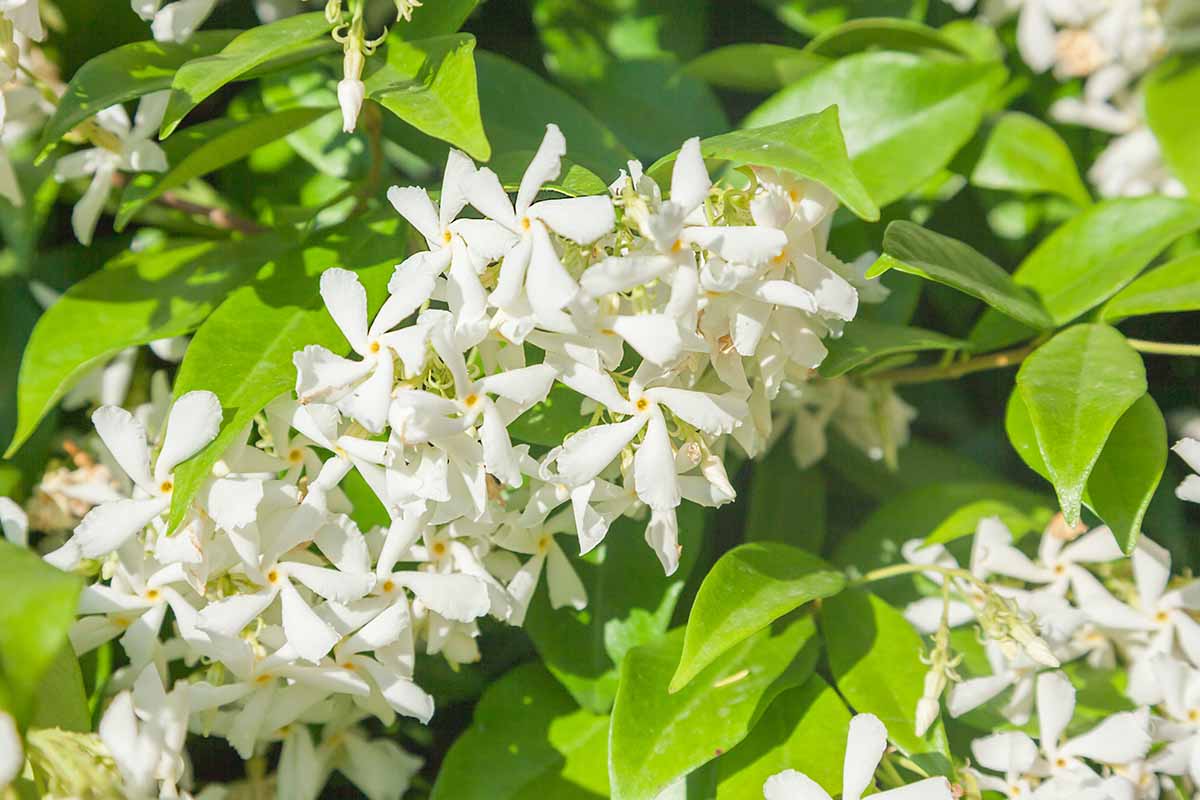
Keep the soil lightly moist for young plants and prune vines after flowering for the best display of flowers and glossy green leaves.
After that, kick back and enjoy the show!
Where and how do you folks use star jasmine as a ground cover? Let us know in the comments section below.
And for more information about different types of jasmine and how to use them in your landscape, be sure to read these guides next:
